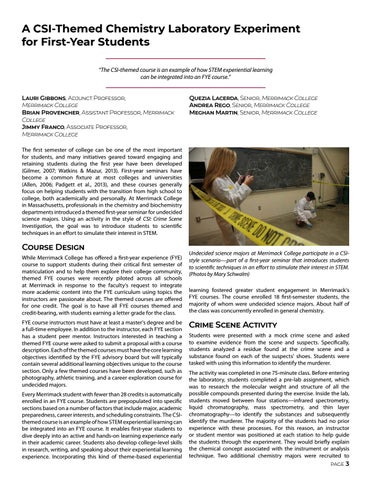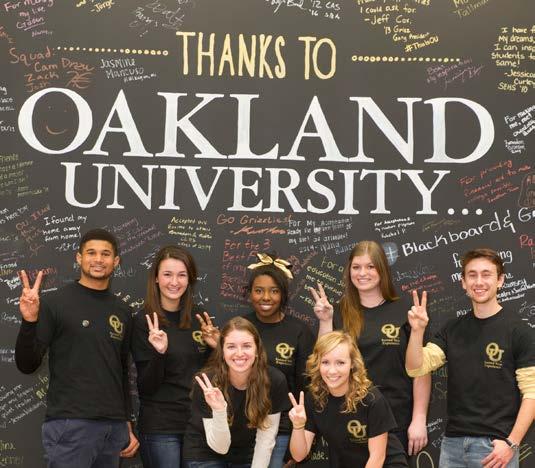A CSI-Themed Chemistry Laboratory Experiment for First-Year Students “The CSI-themed course is an example of how STEM experiential learning can be integrated into an FYE course.” Lauri Gibbons, Adjunct Professor, Merrimack College Brian Provencher, Assistant Professor, Merrimack College Jimmy Franco, Associate Professor, Merrimack College
Quezia Lacerda, Senior, Merrimack College Andrea Rego, Senior, Merrimack College Meghan Martin, Senior, Merrimack College
The first semester of college can be one of the most important for students, and many initiatives geared toward engaging and retaining students during the first year have been developed (Gilmer, 2007; Watkins & Mazur, 2013). First-year seminars have become a common fixture at most colleges and universities (Allen, 2006; Padgett et al., 2013), and these courses generally focus on helping students with the transition from high school to college, both academically and personally. At Merrimack College in Massachusetts, professionals in the chemistry and biochemistry departments introduced a themed first-year seminar for undecided science majors. Using an activity in the style of CSI: Crime Scene Investigation, the goal was to introduce students to scientific techniques in an effort to simulate their interest in STEM.
Course Design While Merrimack College has offered a first-year experience (FYE) course to support students during their critical first semester of matriculation and to help them explore their college community, themed FYE courses were recently piloted across all schools at Merrimack in response to the faculty’s request to integrate more academic content into the FYE curriculum using topics the instructors are passionate about. The themed courses are offered for one credit. The goal is to have all FYE courses themed and credit-bearing, with students earning a letter grade for the class. FYE course instructors must have at least a master’s degree and be a full-time employee. In addition to the instructor, each FYE section has a student peer mentor. Instructors interested in teaching a themed FYE course were asked to submit a proposal with a course description. Each of the themed courses must have the core learning objectives identified by the FYE advisory board but will typically contain several additional learning objectives unique to the course section. Only a few themed courses have been developed, such as photography, athletic training, and a career exploration course for undecided majors. Every Merrimack student with fewer than 28 credits is automatically enrolled in an FYE course. Students are prepopulated into specific sections based on a number of factors that include major, academic preparedness, career interests, and scheduling constraints. The CSIthemed course is an example of how STEM experiential learning can be integrated into an FYE course. It enables first-year students to dive deeply into an active and hands-on learning experience early in their academic career. Students also develop college-level skills in research, writing, and speaking about their experiential learning experience. Incorporating this kind of theme-based experiential
Undecided science majors at Merrimack College participate in a CSIstyle scenario—part of a first-year seminar that introduces students to scientific techniques in an effort to stimulate their interest in STEM. (Photos by Mary Schwalm) learning fostered greater student engagement in Merrimack’s FYE courses. The course enrolled 18 first-semester students, the majority of whom were undecided science majors. About half of the class was concurrently enrolled in general chemistry.
Crime Scene Activity Students were presented with a mock crime scene and asked to examine evidence from the scene and suspects. Specifically, students analyzed a residue found at the crime scene and a substance found on each of the suspects’ shoes. Students were tasked with using this information to identify the murderer. The activity was completed in one 75-minute class. Before entering the laboratory, students completed a pre-lab assignment, which was to research the molecular weight and structure of all the possible compounds presented during the exercise. Inside the lab, students moved between four stations—infrared spectrometry, liquid chromatography, mass spectrometry, and thin layer chromatography—to identify the substances and subsequently identify the murderer. The majority of the students had no prior experience with these processes. For this reason, an instructor or student mentor was positioned at each station to help guide the students through the experiment. They would briefly explain the chemical concept associated with the instrument or analysis technique. Two additional chemistry majors were recruited to
page 3




